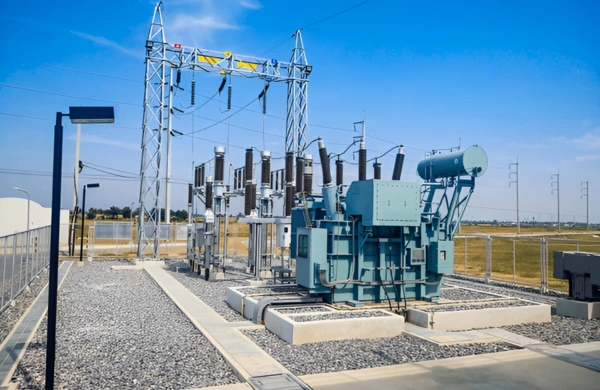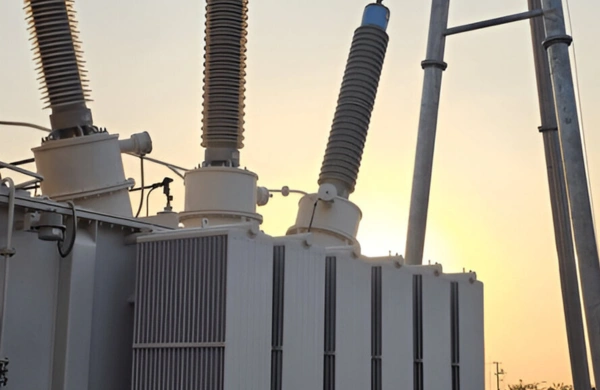Introduction
With growing energy demand, renewable integration, and grid expansion across North America, utilities are prioritizing energy efficiency and loss reduction in every part of their network. Among all grid components, power transformers play a pivotal role in achieving these goals.
Energy-efficient power transformers reduce no-load and load losses, improve voltage regulation, and extend asset life — helping utilities cut operational costs while supporting sustainability targets.
Zetwerk manufactures high-efficiency power transformers engineered for minimal energy loss, superior thermal management, and compliance with DOE, IEC 60076, and IEEE C57.12 efficiency standards. Designed for transmission, substation, and renewable integration applications, these transformers deliver long-term reliability for modern utilities.
Know About Energy Efficient Power Transformers for Modern Utilities
1. The Growing Importance of Transformer Efficiency
Power transformers are among the most energy-intensive assets in the electrical grid. Even small inefficiencies translate into significant energy waste and CO₂ emissions across decades of service.
According to the U.S. Department of Energy (DOE), transformer losses account for nearly 2–3% of total power generation losses in utility networks. By improving transformer efficiency, utilities can reduce both operational costs and carbon footprint.
Efficiency benefits include:
- Reduced system losses and operating costs.
- Lower thermal stress and longer insulation life.
- Improved voltage stability and reliability.
- Support for utility energy-efficiency mandates.
- Contribution to ESG and decarbonization goals.
Zetwerk’s high-efficiency transformers are designed with optimized core materials, advanced winding geometry, and low-loss insulation systems that align with modern energy regulations.
2. Design Principles Behind Energy Efficiency
Zetwerk employs a holistic design approach that optimizes both electromagnetic and thermal performance for maximum efficiency across all load conditions.
Core Design:
Manufactured using grain-oriented CRGO steel or amorphous alloy laminations, offering extremely low hysteresis and eddy current losses. Core joints are step-lapped and precision machined to ensure uniform magnetic flux distribution and minimal stray losses.
Windings:
High-conductivity copper or aluminum windings are designed with optimum cross-section and transposition to reduce proximity and skin effects. Each winding is impregnated and dried under vacuum for high dielectric strength.
Insulation System:
Advanced cellulose, Nomex, or resin-impregnated insulation ensures minimal dielectric loss and thermal stability.
Cooling System:
Optimized for efficient heat dissipation using ONAN, ONAF, or OFAF methods, ensuring stable operation at low temperature rise.
Each design is simulated using finite element analysis (FEA) to validate electromagnetic flux patterns, hot spots, and efficiency under variable loading conditions.
3. Types of Energy Efficient Power Transformers
Zetwerk manufactures a range of power transformers tailored for different utility and industrial applications, each designed to maximize operational efficiency.
a) Oil-Immersed Power Transformers
- Suitable for high-capacity and outdoor installations.
- Uses mineral or ester oil for insulation and cooling.
- High overload capability and long service life.
- Meets DOE and CEC Tier 2 energy efficiency standards.
b) Amorphous Core Transformers
- Uses amorphous metal alloys with 70–80% lower core losses than CRGO steel.
- Ideal for continuous-load distribution and renewable applications.
- Provides exceptional no-load efficiency and reduced heat generation.
c) Dry-Type Power Transformers
- Uses air or resin for insulation — suitable for indoor or sensitive installations.
- Fire-safe, maintenance-free, and efficient for compact substations.
Each type is optimized for specific voltage classes, environments, and efficiency regulations across North American utilities.
4. Electrical and Performance Specifications
Zetwerk’s energy-efficient power transformers deliver consistent performance, durability, and energy savings under demanding grid conditions.
Typical specifications:
- Power range: 1 MVA – 400 MVA
- Primary voltage: Up to 400 kV
- Secondary voltage: As per grid specification
- Efficiency: ≥99.3% (depending on rating)
- Voltage regulation: ±1% to ±1.5%
- Frequency: 50 Hz / 60 Hz
- Thermal class: F (155°C) / H (180°C)
- Insulation level: BIL up to 1,200 kV
These transformers meet DOE 2016, CEC Tier 2, and IEC 60076-20 efficiency benchmarks, ensuring compliance with North American and global energy standards.
5. Reducing Transformer Losses: Core and Load Optimization
Transformer losses fall into two categories — no-load (core) losses and load (copper) losses. Zetwerk engineers optimize both through material selection and precise construction.
No-Load Loss Reduction:
- Use of amorphous or CRGO steel laminations.
- Precision annealing to align magnetic domains.
- Step-lap core assembly to minimize air gaps.
- Reduced magnetizing current for low idle consumption.
Load Loss Reduction:
- Optimized winding design for balanced current distribution.
- Low-resistance conductors to reduce I²R losses.
- Advanced cooling systems maintaining lower operating temperature.
- Enhanced clamping structure minimizing mechanical movement during faults.
Together, these design optimizations extend service life while improving return on investment through lower total energy costs.
6. Environmental and Economic Advantages
Efficiency improvements in power transformers directly contribute to sustainability goals and reduced lifecycle costs.
Economic benefits:
- Lower energy losses mean reduced generation and distribution costs.
- Extended service life reduces replacement frequency.
- Reduced heat losses minimize cooling system energy consumption.
Environmental benefits:
- Reduction in greenhouse gas emissions through decreased energy waste.
- Use of eco-friendly ester oil and recyclable core materials.
- Compliance with RoHS, REACH, and other environmental directives.
Zetwerk’s efficient designs help utilities meet EPA, DOE, and ESG sustainability objectives while maintaining long-term grid reliability.
7. Quality, Testing, and Compliance
Each Zetwerk transformer undergoes comprehensive testing to validate energy performance, insulation strength, and mechanical integrity.
Testing includes:
- No-load and load loss measurement (per IEEE C57.12.90).
- Ratio and polarity verification.
- Short-circuit withstand test.
- Temperature rise and thermal endurance tests.
- Impulse and dielectric strength testing.
- Partial discharge and sound level verification.
Zetwerk’s test results are certified to meet DOE 10 CFR 431, IEC 60076, and IEEE C57.12 standards. Each unit is delivered with a complete Factory Acceptance Test (FAT) report documenting efficiency metrics and test outcomes.
8. Digital Monitoring and Smart Efficiency Tracking
To complement mechanical and electrical design improvements, Zetwerk’s high-efficiency power transformers can be equipped with smart transformer monitoring systems for continuous performance tracking.
Integrated features include:
- Real-time load, temperature, and oil level monitoring.
- Loss tracking and energy efficiency analytics.
- Predictive maintenance alerts for insulation and winding health.
- SCADA and IoT integration using IEC 61850 protocols.
These digital enhancements help utilities optimize loading, reduce downtime, and maintain high operational efficiency over decades of service.
9. Zetwerk’s Manufacturing and Engineering Capabilities
Zetwerk’s vertically integrated manufacturing ecosystem ensures precise material control, automated fabrication, and quality consistency.
Manufacturing highlights:
- CNC-controlled core cutting for high magnetic accuracy.
- Automated coil winding and drying systems.
- Vacuum oil filtration and degassing units for dielectric stability.
- Fully automated FAT setups with data acquisition.
- ISO 9001, ISO 14001, and ISO 45001 certified facilities.
Zetwerk also offers end-to-end engineering support — from design and prototyping to logistics and installation — ensuring project success for North American utilities and EPCs.
10. Supporting Modern Utilities Across North America
Zetwerk’s high-efficiency power transformers serve utilities, independent power producers (IPPs), and industrial facilities focused on energy savings and operational excellence.
Key advantages for North American projects:
- Compliance with DOE, IEEE, IEC, and CSA efficiency standards.
- Custom designs for substation, renewable, and industrial use.
- Long service life with minimal maintenance.
- Proven reliability in diverse climates and load conditions.
- Scalable manufacturing for both standard and custom units.
Zetwerk’s efficiency-first approach ensures that each transformer delivers measurable operational savings and supports sustainable grid development.
Conclusion
Energy-efficient transformers are essential to achieving the goals of modern, sustainable utilities — reducing losses, improving grid reliability, and lowering operational costs. As transmission and distribution systems evolve to support renewable energy and digital control, efficient transformer design has become a core priority.
Zetwerk manufactures high-efficiency power transformers engineered for maximum energy conservation, mechanical reliability, and compliance with international standards. Built with advanced materials, optimized winding design, and smart monitoring options, Zetwerk’s transformers enable utilities to operate greener, smarter, and more efficiently.
With engineering expertise, manufacturing excellence, and consistent quality assurance, Zetwerk continues to power North America’s energy transition with technology-driven transformer solutions.




FAQs
a. Use of low-loss core materials, optimized winding design, and improved cooling reduces total energy losses.
a. Yes. All units comply with DOE 10 CFR 431 and CEC Tier 2 efficiency requirements.
a. Typically 25–35 years, depending on load cycles and environment.
a. Yes. Zetwerk offers IoT-enabled transformers with real-time loss and health tracking.
a. Absolutely. These transformers are ideal for solar, wind, and hybrid power applications.








